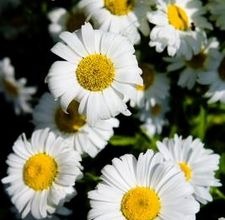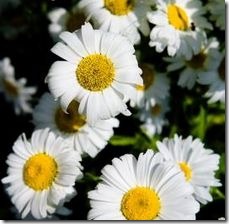Thousands of different species of daisy grow around the world, blooming in colors as diverse as violet, pink and yellow. However, the white Bellis perennis, also known as the English daisy, is perhaps the most iconic species of the flower. Deriving its name from the Latin word for "pretty," this bright and resilient small blossom brightens up gardens — often escaping into the lawn — with little to no care.
Identification
-
The herbaceous Bellis perennis flower grows on a short, fuzzy stem in an upright fashion. This herb sticks very close to the ground, reaching heights of only about 3 to 8 inches. Leaves that sprout from the base of the plant’s stem feature winged petioles and grow up to 1.5 inches long in an alternating fashion. The plant’s egg-shaped top leaves feature a fuzzy texture, similar to but softer than that of the stem. The flower of the Bellis perennis features two layers of long thin, oval-shaped white petals that grow densely atop each other and form a round shape. Though it is characteristically white, the Bellis perennis may sometimes appear with pale pink petals. The flower’s stigma sports a bright yellow color.
Growth Habits
-
The perennial English daisy begins to grow in the late winter season. Seeds of this plant ripen from the spring to autumn months, and its bright white blooms appear in the spring through summer seasons. These hermaphrodite flowers — pollinated by bees, flies and beetles — are self-fertile. Hardy white daisies naturally appear in lawns and meadows, as well as all sorts of unexpected places, including roadsides and waste sites.
Habitat
-
The Bellis perennis thrives in full sun or partial shade, even tolerating some frost. Though the white daisy needs moist soil, it isn’t picky about soil type, thriving in light sandy, medium loamy and heavy clay soils, so long as the soil is well-drained and fertile. Bellis perennis flourishes in acid, neutral and basic soil types. The English daisy grows in 27 U.S. states, from California to Utah to Virginia, as well as Canada, the Pacific Islands, South America and countries throughout Europe and western Asia. In the United States, this plant grows in USDA hardiness zone 4 through 10.
Medicinal Characteristics
-
Gardeners often use this plant as an ornamental, but the Bellis perennis is also used in herbal medicine, in teas and as a vitamin supplement. Traditionally, white daisies treat wounds and may possess a calming effect. Bellis perennis has the subtle properties of an anodyne, a digestive, an expectorant and a laxative.


Deprecated: strpos(): Passing null to parameter #1 ($haystack) of type string is deprecated in /home/agriviek8Qv/agriviet.net/public_html/wp-includes/comment-template.php on line 2522